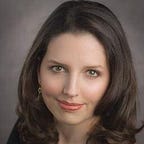Madam President,
Role Model In Chief
Research indicates that women elected to statewide office can inspire other women to enter politics and move up the ladder. Could electing a woman president be the ultimate recruitment tool?
In America today, women constitute only 24% of state legislators, 19% of Congress, and 10% of governors nationwide. Of the country’s 100 largest cities, only 13 have mayors that are women. Only two women of color have ever been elected to the U.S. Senate.
For decades, women’s organizations have chipped away at the representation deficit by recruiting, training, and supporting female candidates. As I’ll mention later, these groups have made a real and measurable difference to current representation levels; without them, the gap would be even wider.
Recruitment is hard work, though. Academics and political insiders have long known that convincing women to throw their hat in the ring — indeed, just getting women to view themselves as qualified — is one of the toughest hurdles in the fight for gender parity in politics. (Men, on the other hand, tend to view themselves as eminently qualified even when they are not.) Once women choose to run, all evidence says they are just as good at raising money and winning votes as similarly-situated male candidates, and often better. But to make that leap and become a candidate, a woman must first defy the cultural and institutional barriers that have cast politics as a man’s game. Recruitment remains an important, if painstaking, means of getting women into the pipeline, since women rarely recruit themselves.
But what if there were a shortcut? With all the talk of Hillary Clinton’s likely run for president, I started thinking back to the research on women in politics that I undertook as an undergrad and Masters student at Harvard. By analyzing 30 years of data across 49 states, I found that when women are elected to governorships, their states end up with more women state legislators in the future. The same thing happens in states where women are elected Attorney General or U.S. Senator. In other words, elect a woman to a prominent office today, and you’ll see more women entering politics at lower levels tomorrow.
There is no office more prominent than President of the United States. A female president would be a highly visible role model to women and girls, literally modeling the role that women can and should play in politics.
Here’s how my study worked. I controlled for all variables known to affect gender ratios in state legislatures—things like regional ideology and legislative professionalization. Then I added some new variables, looking specifically for events and activities that predicted future increases in female representation. (For you stats nerds out there, I used a fixed-effects multiple regression model with time-lagged panel data.) The old correlation-does-not-equal-causation maxim still applies, but using time lags does give us much better hints about causal/directional relationships between variables.
The main focus of my research was on women’s political recruitment organizations — mostly state-level versions of groups like EMILY’s List and the National Women’s Political Caucus. Their efforts, I found, had a small but statistically significant effect. The average state-level women’s recruitment organization increased women’s future share of the legislature by one percentage point. Of course, many states had multiple women’s groups, and efforts were often sustained over time. So even single percentage points can add up.
Electing a woman Governor, Senator, or AG, on the other hand, increased women’s future legislative share by two to three percentage points. If these numbers sound small, consider that the average rate of growth in female legislative representation in the last two decades has been about two-tenths of a percentage point per year. A leap of 2–3% is actually quite respectable. In the report I speculated that this was evidence of the importance of role models for inspiring women to enter public life: “The indirect recruitment power of a highly visible elected woman surpasses the direct recruitment power of a typical women’s organization.”
This is not how we usually think of the pipeline. We expect a linear progression, where having lots of women at the entry level is predictive of a future full of women at the highest levels. But the pipeline, in reality, is a virtuous cycle. Women in powerful positions aren't just serving as role models to little girls—they’re normalizing politics for adult women who may need a little nudge. Imagine, for instance, a mom who’s been volunteering on her local school board. After seeing a woman elected Governor, the mom decides it’s finally time to make a run for that legislative seat she’s been eyeing.
Now imagine that our new legislator sees a woman elected President. True, I don’t have proof that this will nudge her forward; it’s possible that the state-level effects I've identified won’t operate in the same way on a national level. But it’s reasonable to believe that after watching a woman run for and win the Presidency, a run for Congress or the Governor’s mansion won’t seem so intimidating to women in the earlier stages of their political careers.
If a woman president was able to inspire just a two percentage-point increase in female representation at lower levels, we’d get one additional governor, eleven more members of Congress, and 148 new state legislators.
Wisely, women’s organizations have always pursued a multi-tiered approach to recruiting and supporting women candidates at all levels. And for any of us who care about seeing more women in politics, 2016 is big. The opportunity to elect the first woman president should be valued not just because it will be historic and symbolic, but also because it will reinvigorate the virtuous cycle of recruitment.
To get more women on all rungs of the political ladder, let’s put a woman on top of it.
Amelia Showalter is a data expert and political consultant who served as Director of Digital Analytics on the 2012 Obama campaign. She lives in Washington, DC, and tweets at @ameliashowalter.
